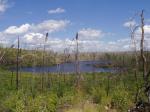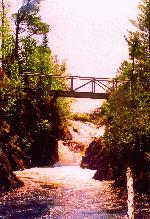BWCA Entry Point, Route, and Trip Report Blog
July 26 2024
Entry Point 52 - Brant Lake
Number of Permits per Day: 4
Elevation: 1500 feet
Latitude: 48.0692
Longitude: -90.8455
Brant to Tuscarora via Little Sag Route:
Round
Brant
Bat - Mud
Gillis - burn area is evident:

French
Peter - first lake trout:

Virgin
Little Sag - green trees again!
Mora - gorgeous divide of burn and green
Crooked
Owl
Tuscarora - second lake trout!
Missing Link - with lighter food pack, the portage is OK
Round
Little Saganaga Region
Entry Date:
May 31, 2005
Entry Point:
Brant Lake
Number of Days:
6
Group Size:
2
I am happy to say that I came through it all unscathed, liberal diatribes not withstanding. The weather was almost as perfect as it can get and a surprise for the first week of June. It was a little warmer than ideal, but 70's and sunshine for seven days straight isn't much to bitch about. The biggest surprise was the lack of bugs. When SWK suggested an early June trip, I had images of constant harassment by winged assassins. But this fear turned out to be unfounded. Some of the portages were a little buggy but not much worse than any I have experienced on warm days in late September. Our choice of campsites was a critical factor in being spared the ravages of the bloodsuckers. All were open to a breeze that kept most of the little bastards at bay. There was apparently some insect activity, however, as we talked to some other parties who weren't so lucky with their sites. They complained mostly of flies. The most prevalent offenders we encountered were ticks. I estimate that we each (including the dog) pulled an average 5 - 10 ticks off of ourselves per day. Again, if this is as bad as it gets on the bug front, I'm in no position to complain.
As for the route, it proved interesting and somewhat challenging. We put in at Round Lake at about 8 am and made our way west through West Round, Edith and Brant. The three short portages here were as easy as you find in Boundary Waters. The next five carries that would take us to Gillis were something else entirely. None of these are what can be considered long, the longest being no more than 90-100 rods. But what they lacked in distance they made up for elevation change. Each one them climbed steeply and descended just as steeply on the other end. The landings at these portages were the other memorable challenge. I know of several 200 - 300 rod carries I would rather brave than this series. What made it worse were the short paddles between the toiling in the harnesses. Gotter, Flying and Green Lakes are short 10 minute paddles, not offering much opportunity to recharge. Reaching Gillis quickly put all the sweat and strain into perspective. A large, deep lake with crystal clear water, Gillis was a sight to behold. Although we only passed though the northern part of the lake enroute to our base camp on Little Saganaga, we knew we would have spend a night here on the way out.
The five portages from Gillis to Little Sag were much more forgiving and we made good time and had our base camp set up by the time darkness fell. We chose the northernmost site on the lake on a finger-like peninsula. In addition to a great view of the lake, it offered a constant breeze from the southeast, south, and southwest. This would be our home for the next five days as we lounged, fished, and explored the area. The highlight of camp was a spruce grouse which every morning starting at about 7 am would fly back and forth between a fallen pine and an old stump right outside the door of our tent. The noise was deafening and served as our alarm clock. Speaking of noise, the loons were everywhere on Little Sag. We had them on all sides of us and throughout every day and night they were constantly wailing. At one time, we could identify at least seven different locations around the lake from which they were calling. We often had one pair cruise right up off our camp and begin their songs.
Our day trips north to Ogishkemuncie were very rewarding. The series of cascades along nearly every portage we crossed made the carries a joy. We caught lake trout while leisurely cruising our way across Gabimichigami to Agamok. The route from Agamok through Mueller and Ogishkemuncie offered me my first good look at the extensive blowdown left by the 1999 storm. Since the storm, I had largely confined my trips to the area northwest of Ely, an area untouched by the tempest. Looking at the damage up close, I can only imagine what it would have been like to be caught in the middle of it. From what I could see, the forest is making quite a recovery. If it doesn't burn over, soon the only thing left visible will be the taller snags poking through the green pioneer growth. The most interesting part of the day trip, however, was the area where the Agamok-Mueller portage crosses the famed Kekekabic Trail. The flowage between the lakes cousres through a number of unnamed ponds and then through a series of thundering cascades. The trail bridge crosses directly above these providing a great vantage point.
After several days on Little Sag, we decided to make for Gillis where we would spend our last night. We took the southern route through Mora, Tarry, and Crooked Lakes. This short stretch proved to be what I consider to be the most picturesque section of the whole trip. Short, easy portages separated by leisurely paddles awaited us on this route. Unlike the northern section of our journey, this stretch was far more dominated by conifers, lending a cool darkness to the feeling as we traveled. Rushing rapids through enchanted cedar forests were found along the portages between Tarry and Crooked and Crooked and Gillis. We really took our time to enjoy this day, taking numerous breaks to sit in the deep green shade along side the rushing waters. At the south end of the Crooked-Gillis portage there sits the remains of a log cabin. I'm going to have to look into this to see what its origins might be. By the time we reached Gillis, a strong west wind had blown up and we made for a site high up on the eastern shore. After setting up camp and a quick swim to cool off, we observed what appeared to be the first storm clouds of the trip moving in from the west. If the storm was to pack any kind of punch, we would get the worst of it. We knew this site offered great views of the lake and sky. We also knew it was totally exposed to whatever it wished to hurl at us. We stowed our gear and guyed out the tent and then watched the coming of the storm. Over the next three hours we watched the dark clouds go to our south and to our north again and again. On both sides of us we could see and even smell the rain. By the time it was all over, we were a little windblown, but completely dry. Thus ended our last night of the trip.
The trip out was uneventful. This would be our warmest and muggiest day so far with the sky seemingly always threatening rain. A good way to end the trip. After such good conditions for week, less then great weather makes having to leave a little easier to take. The experience of my first June trip was an overwhemling success. We saw surprisingly few people until the last leg from Green to Round Lake and those parties were coming in. It wasn't hot; decent fishing; no bugs to speak of; I didn't have to use SWK as an anchor; Even Tasha, SWK's dog survived (although at times I wasn't sure she would make it). 






